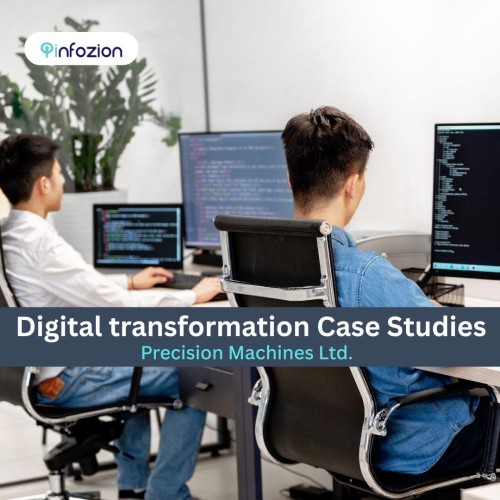Digital transformation Case Studies (Precision Machines Ltd.)

Digital transformation Case Studies (Precision Machines Ltd.)
Manufacturing Firm Reduces Downtime by 40% with IoT Integration
Client Overview
Client Overview
- – Company: Precision Machines Ltd.
- – Industry: Manufacturing
- – Location: Asia
Background and Challenges
Precision Machines Ltd., a leading manufacturer of industrial components in Asia, faced growing operational challenges as they sought to scale their production. Key issues included:
- – Frequent Machine Downtime: Unplanned equipment failures disrupted production schedules and increased maintenance costs.
- – Lack of Real-Time Monitoring: The absence of continuous monitoring led to delays in identifying and resolving issues.
- – Inefficient Maintenance Practices: Relying on reactive and time-based maintenance strategies resulted in wasted resources.
- – Data Silos: Disparate systems across production lines limited insights into overall equipment efficiency (OEE) and performance trends.
To remain competitive and meet increasing demand, Precision Machines Ltd. needed a robust solution to optimize production and minimize downtime.
Objectives
The company’s digital transformation initiative focused on:
- – Reducing Machine Downtime: Proactively identify and address potential failures.
- – Implementing Real-Time Monitoring: Enable continuous tracking of equipment health and performance.
- – Optimizing Maintenance: Shift to predictive maintenance strategies to reduce costs and improve efficiency.
- – Enhancing Data Integration: Centralize production data for better decision-making.
Digital Transformation Strategy
Precision Machines Ltd. partnered with a leading IoT solutions provider to implement a comprehensive Industry 4.0 strategy. The approach included:
1. IoT Sensor Deployment
- – Installed IoT sensors on critical machinery to monitor parameters such as temperature, vibration, pressure, and energy consumption.
- – Ensured compatibility with legacy equipment using retrofit solutions.
- – Established a secure connection for transmitting data to the cloud.
2. Centralized Data Platform
- – Integrated all IoT sensor data into a centralized cloud-based platform.
- – Enabled real-time visualization of equipment performance through a user-friendly dashboard.
- – Ensured data accessibility across teams for collaborative problem-solving.
3. Predictive Maintenance Implementation
- – Leveraged machine learning algorithms to analyze historical and real-time data.
- – Identified patterns and anomalies to predict potential equipment failures.
- – Automated maintenance alerts to ensure timely intervention.
4. Enhanced Production Analytics
- – Deployed analytics tools to track key performance indicators (KPIs) such as OEE, production throughput, and energy efficiency.
- – Generated actionable insights to optimize machine usage and production schedules.
5. Staff Training and Change Management
- – Conducted workshops to train maintenance teams and operators on the new IoT-enabled systems.
- – Implemented a phased rollout to minimize disruptions and ensure smooth adoption.
Results and Benefits
The IoT integration delivered transformative results for Precision Machines Ltd.:
1. Reduced Downtime
- – 40% Decrease in Downtime: Predictive maintenance and real-time monitoring significantly reduced equipment failures.
- – Faster issue resolution due to immediate alerts and actionable insights.
2. Improved Maintenance Efficiency
- – 20% Reduction in Maintenance Costs: Predictive maintenance replaced costly time-based routines.
- – Reduced inventory costs for spare parts through better planning.
3. Enhanced Operational Visibility
- – Real-time dashboards provided comprehensive insights into production performance.
- – Data-driven decisions improved resource allocation and scheduling.
4. Increased Productivity
- – 15% Improvement in OEE: Optimized machine uptime and throughput.
- – Enhanced energy efficiency reduced operational costs.
4. Scalable Infrastructure
- – The IoT platform provided a scalable foundation for future innovations, including automated quality control and supply chain optimization.
Conclusion
By integrating IoT technology, Precision Machines Ltd. transformed its operations, achieving substantial reductions in downtime and maintenance costs while improving overall efficiency. This case highlights the immense potential of IoT-driven digital transformation in modern manufacturing.
Precision Machines Ltd.’s success underscores the value of leveraging real-time data and predictive analytics to enhance performance and remain competitive in a rapidly evolving industry.
Testimonial
“IoT has transformed our operations, helping us minimize downtime and significantly reduce costs.”
Healthcare Provider Enhances Patient Experience with Digital Transformation
Client Overview
- – Company: CareWell Clinics
- – Industry: Healthcare
- – Location: Europe
Background and Challenges
CareWell Clinics, a prominent healthcare provider in Europe, operates over 50 multispecialty clinics. With a growing patient base and increasing demand for personalized care, CareWell faced several challenges, including:
- – Fragmented Patient Data: Patient records were stored across multiple systems, leading to delays in accessing critical information.
- – Inefficient Appointment Management: High no-show rates and overbooked slots caused operational inefficiencies.
- – Limited Remote Care Options: The absence of telemedicine services restricted access for patients in rural or remote areas.
- – Patient Engagement Gaps: : Lack of a unified platform for communication and engagement with patients.
Recognizing the urgent need for modernization, CareWell embarked on a digital transformation journey to enhance patient experience and streamline operations.
Objectives
The key goals of CareWell’s digital transformation initiative included:
- – Centralizing Patient Data: Implement a unified electronic health record (EHR) system.
- – Improving Appointment Scheduling: Enable automated and patient-friendly appointment systems.
- – Introducing Telemedicine: Provide virtual consultation services to expand access to care.
- – Enhancing Patient Engagement: Develop a patient portal and mobile app for seamless communication and access to medical records.
- – Boosting Operational Efficiency: Optimize clinic workflows using digital tools.
Digital Transformation Strategy
CareWell partnered with a leading IT solutions provider to implement a comprehensive digital transformation strategy. The approach included:
1. Adopting a Unified EHR System
- – Consolidated all patient records into a single, cloud-based EHR platform.
- – Integrated the EHR with lab systems, radiology platforms, and pharmacy databases for real-time data sharing.
- – Enabled secure access to patient data for authorized personnel across all clinic locations.
2. Automating Appointment Scheduling
- – Introduced an AI-powered scheduling system that optimized appointment slots and reduced no-show rates.
- – Enabled online booking through a dedicated patient portal and mobile app.
- – Added automated reminders and follow-ups via SMS and email.
3. Launching Telemedicine Services
- – Developed a secure telemedicine platform for virtual consultations.
- – Integrated video conferencing, prescription generation, and follow-up scheduling into the platform.
- – Provided training to staff and physicians for effective use of telehealth tools.
4. Creating a Patient-Centric Portal and App
- – Designed a user-friendly patient portal and mobile app with features such as:
- o Access to medical records, test results, and prescriptions.
- o Appointment booking and teleconsultation options.
- o Health tips, reminders, and personalized care plans.
- – Enabled multilingual support to cater to a diverse patient demographic.
5. Optimizing Operations with Digital Tools
- – Implemented workflow automation tools to streamline administrative tasks such as billing and insurance claims.
- – Deployed analytics to monitor patient feedback, operational metrics, and clinic performance.
- – Used predictive analytics to anticipate patient demand and allocate resources efficiently.
Results and Benefits
CareWell Clinics witnessed significant improvements in patient care and operational efficiency following the digital transformation:
1. Enhanced Patient Experience
- – Reduced Wait Times: Centralized records and automated scheduling minimized delays in patient care.
- – Improved Access to Care: Telemedicine services expanded healthcare reach to rural and underserved areas.
- – Better Engagement: The patient portal and app facilitated seamless communication, resulting in a 40% increase in patient satisfaction scores.
2. Increased Operational Efficiency
- – Optimized Appointments: No-show rates decreased by 25%, and appointment slots were utilized more effectively.
- – Streamlined Workflows: Automation reduced administrative overhead, saving approximately 30% in operational costs.
3. Data-Driven Decision Making
- – Real-time access to patient and operational data enabled informed decision-making for care and resource allocation.
- – Predictive analytics helped anticipate seasonal trends, allowing clinics to prepare for increased patient inflow.
4. Revenue Growth
- – Enhanced patient retention and expanded service offerings, including telehealth, contributed to a 15% increase in revenue within the first year.
Conclusion
Through strategic digital transformation, CareWell Clinics successfully addressed its challenges and established itself as a leader in patient-centric care. By leveraging advanced technologies, the organization not only enhanced patient experience but also achieved sustainable growth and operational excellence.
This case underscores the potential of digital solutions to revolutionize healthcare delivery and emphasizes the importance of a well-planned transformation strategy.
Testimonial
“Our digital transformation journey has improved not just our operations but also how we connect with and serve our patients.”
Retail Giant Achieves 50% Efficiency Boost with AI and Cloud Computing
Client Overview
- – Company: Global Retail Corp
- – Industry: Retail
- – Location: United States
Background and Challenges
Global Retail Corp, a leading retail chain with a footprint spanning thousands of stores across the United States, faced mounting challenges in its operations:
- – Inventory Management Inefficiencies: Overstocking and understocking issues led to revenue losses and increased costs.
- – Lack of Real-Time Insights: Disparate systems and siloed data restricted visibility into sales trends and customer behavior.
- – Manual Processes: Critical operations such as demand forecasting and supply chain management relied heavily on manual input, causing delays and inaccuracies.
- – Rising Operational Costs: Increasing competition and market volatility demanded greater efficiency and cost optimization.
To address these issues, Global Retail Corp embarked on a digital transformation journey focused on leveraging AI and cloud computing to streamline operations and enhance decision-making.
Objectives
The primary goals of the digital transformation initiative were:
- – Optimizing Inventory Management: Use AI to improve demand forecasting and reduce wastage.
- – Enhancing Operational Efficiency: Automate key processes to minimize manual errors and delays.
- – Improving Decision-Making: Implement real-time analytics for actionable insights.
- – Reducing Costs: Drive cost savings through smarter resource utilization and streamlined operations.
Digital Transformation Strategy
Global Retail Corp partnered with a leading technology provider to implement a robust AI and cloud computing strategy. The approach included:
1. Implementing AI-Driven Demand Forecasting
- – Deployed machine learning algorithms to analyze historical sales data, market trends, and external factors like weather and local events.
- – Enabled predictive analytics to accurately forecast demand for each product category across regions.
- – Reduced dependency on manual forecasting, improving accuracy and reducing waste.
2. Migrating to a Cloud-Based Infrastructure
- – Transitioned legacy systems to a scalable, cloud-based platform.
- – Centralized data storage and processing to ensure seamless integration across departments.
- – Improved system reliability and reduced downtime with robust cloud infrastructure.
3. Automating Supply Chain Operations
- – Introduced AI-powered tools to optimize supply chain activities, including warehouse management and transportation logistics.
- – Automated replenishment processes based on real-time inventory levels and sales data.
- – Enhanced supplier collaboration through cloud-based portals.
4. Leveraging Real-Time Analytics
- – Integrated business intelligence (BI) tools for real-time dashboards and reporting.
- – Provided store managers and executives with actionable insights into sales, customer preferences, and operational performance.
- – Enabled proactive decision-making to address challenges as they arise.
5. Enhancing Customer Experience
- – Used AI to personalize marketing campaigns based on customer purchase histories and preferences.
- – Integrated loyalty programs and targeted promotions into the cloud platform for seamless execution.
- – Enabled self-service options in stores, including AI-assisted kiosks and mobile apps.
Results and Benefits
The AI and cloud computing transformation delivered significant results for Global Retail Corp:
1. Boosted Operational Efficiency
- – Achieved a 50% improvement in overall efficiency by automating manual processes and optimizing workflows.
- – Reduced lead times in the supply chain by 30% through real-time data sharing and analytics.
2. Improved Inventory Management
- – Cut inventory holding costs by 20% through more accurate demand forecasting.
- – Reduced instances of stockouts and overstocking by 40%.
3. Enhanced Decision-Making
- – Real-time insights allowed quicker response to market changes, improving agility.
- – Analytics-driven decision-making resulted in a 15% increase in revenue within the first year.
4. Cost Savings
- – Saved approximately $10 million annually in operational costs by optimizing inventory and supply chain processes.
- – Lowered IT infrastructure costs by migrating to the cloud.
5. Improved Customer Satisfaction
- – Personalized promotions and seamless omnichannel experiences led to a 25% increase in customer satisfaction scores.
- – AI-driven engagement increased customer retention by 10%.
Conclusion
Global Retail Corp’s digital transformation demonstrates the transformative power of AI and cloud computing in the retail sector. By automating processes, leveraging predictive analytics, and centralizing operations, the company significantly improved efficiency, reduced costs, and enhanced customer satisfaction.
This case highlights how a strategic approach to technology adoption can drive measurable business outcomes and position organizations for long-term success in a competitive market.
Testimonial
“The transformation has not only streamlined our operations but also elevated our customer experience. We’re now equipped for sustainable growth.”
Problem
Finding new repeat customers and generating quality leads.
Solution
We helped the brand in the development of lead generation strategies including ways to improve content marketing, creating an innovative social media strategy, expanding the network on sites like LinkedIn, nurturing existing relationships, and converting them to quality leads.
Our Approach
- – Setting clear goals
- – Setting a specific target audience
- – Improving existing content marketing strategies
- – Nurturing existing customer relationship
- – Converting into quality leads
Problem
Targeting the wrong keywords
Solution
One of the biggest SEO challenges is to target the wrong keywords. Keywords are an important part of SEO. Our compelling team of SEO experts helped this brand target long-tail keywords that helped it appear in top search results.
Our Approach
- – Revising the SEO keyword strategy
- – Focused on keywords that have three or more words
- – Targeting long tail keywords
- – Increase in customer visits
Problem
Improper website development strategy
Solution
Finding the perfect development strategy is one of the major business challenges while building a website. Our team of compelling web developers helped the brand formulate a consistent and streamlined development strategy.
Our Approach
- – Defining the goals
- – Using the web development strategy through an automated process
- – Used different approaches for testing, deployment, and maintenance of the website
- – Sprint-based development helped in completing the website development strategy on time
Problem
Poor custom software development design
Solution
Even with the complete functionality, custom software fails if the UI/UX design feels confusing or outdated. Our expert team of custom software developers understood the user needs and perspectives. We planned an information architecture to provide logical content flow and interaction.
Our Approach
- – Understood target users through interviews and research surveys
- – Conducted user research and user personas
- – Prioritized user friendly interface and intuitive navigation
- – Performed usability testing and collected feedback
Problem
Bridging the gap between design and development
Solution
One of the biggest user interface challenges is to bridge the gap between design and development. Our designers carefully managed the brand to make it presentable and appealing. Moreover, our developers appreciate the aesthetics.
Our Approach
- – Our designers used the collaboration tools to establish the collaborative environment
- – Conducted regular cross-team meetings
- – Articulated design objectives with the development strategies
- – Created shared jargon to ensure both teams are on the same pace





